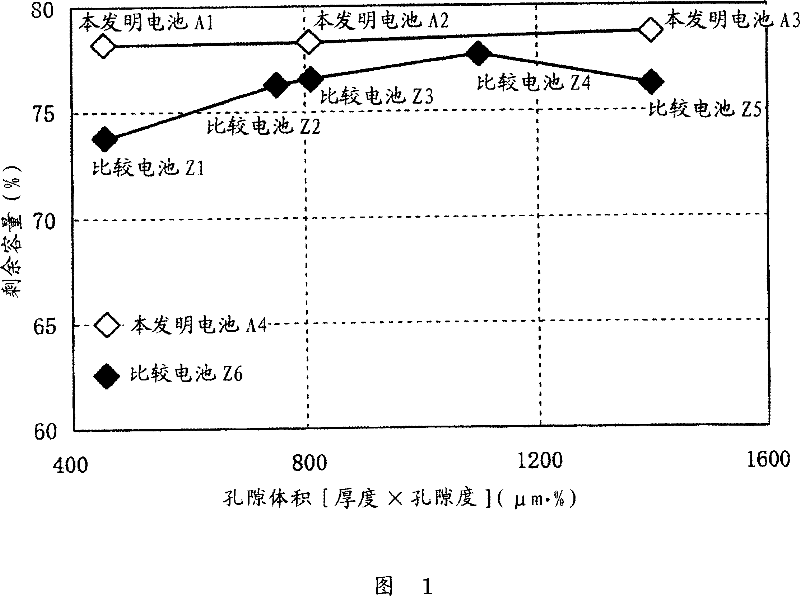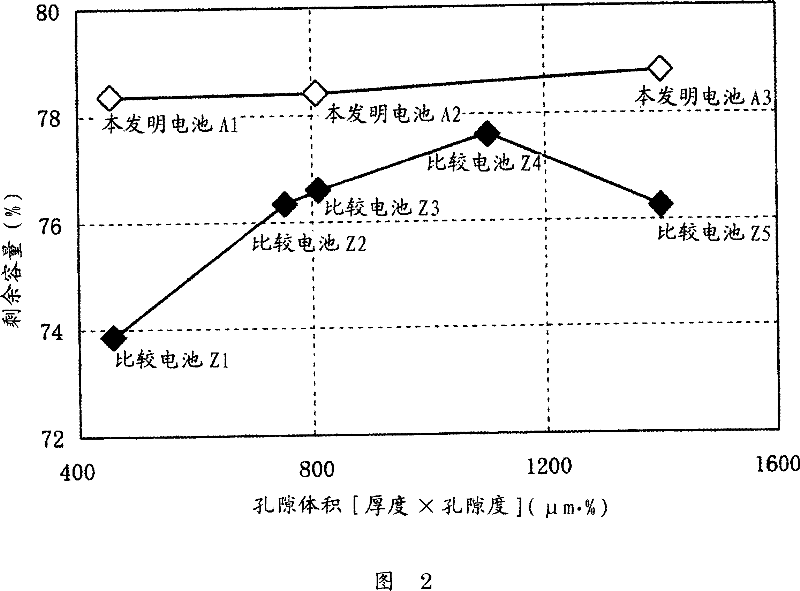Non-aqueous electrolyte battery
A non-aqueous electrolyte and battery technology, used in non-aqueous electrolyte storage batteries, electrolyte storage battery manufacturing, secondary batteries, etc., can solve problems such as large capacity deterioration, insufficient stability or cycle characteristics, etc.
- Summary
- Abstract
- Description
- Claims
- Application Information
AI Technical Summary
Problems solved by technology
Method used
Image
Examples
preparation example Construction
[0068] [Preparation of non-aqueous electrolyte solution]
[0069] Mix ethylene carbonate (EC) and diethyl carbonate (DEC) at a volume ratio of 3:7, and dissolve lithium hexafluorophosphate (LiPF 6 ), to prepare a non-aqueous electrolyte.
[0070] [Production of diaphragm]
[0071] First, in acetone as a solvent, 5% by weight of inorganic particles TiO 2 [Rutile type structure, particle size 0.38μm, KR380 manufactured by Titanium Industry Co., Ltd.], relative to TiO 2 It is a copolymer (rubber-like polymer) containing 10% by weight of acrylonitrile structure (unit), and then mixed and dispersed using Filmics manufactured by a special machine to prepare TiO dispersed 2 of slurry. Next, the above-mentioned membrane was coated on both sides of a separator formed of a polyethylene (hereinafter abbreviated as PE) microporous membrane (thickness: 12 μm, porosity measured as described later: 38%) by dip coating method. The slurry is dried and the solvent of the slurry is removed ...
Embodiment 1
[0081] Example 1 uses the battery shown in the foregoing detailed description.
[0082] Hereinafter, the battery thus produced is referred to as battery A1 of the present invention.
Embodiment 2
[0084] A battery was fabricated in the same manner as in Example 1, except that a separator having a film thickness of 18 μm and a porosity of 45% [pore volume: 810 (μm·%)] was used.
[0085] Hereinafter, the battery thus produced is referred to as battery A2 of the present invention.
PUM
| Property | Measurement | Unit |
|---|---|---|
| thickness | aaaaa | aaaaa |
Abstract
Description
Claims
Application Information
 Login to View More
Login to View More - R&D
- Intellectual Property
- Life Sciences
- Materials
- Tech Scout
- Unparalleled Data Quality
- Higher Quality Content
- 60% Fewer Hallucinations
Browse by: Latest US Patents, China's latest patents, Technical Efficacy Thesaurus, Application Domain, Technology Topic, Popular Technical Reports.
© 2025 PatSnap. All rights reserved.Legal|Privacy policy|Modern Slavery Act Transparency Statement|Sitemap|About US| Contact US: help@patsnap.com


